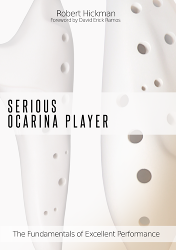This hand made double alto D ocarina is ideal for playing Irish traditional music. It has a range matching the tin whistle (C#5 to B6), and covers the sounding range of all common Irish tunes.
The Pacchioni system and Irish traditional music
Playing Irish music on this ocarina is easier than Asian double ocarinas as it makes use of the Pacchioni system:
- The chambers are tuned an octave apart, and have two notes of overlap. The second chamber thus fingers identically to the right hand of the first chamber, sounding an octave higher.
- The ocarina behaves almost identically to a tin whistle regarding finger ornamentation. The chamber break is between C sharp and D like a tin whistle. Every note that can be rolled on a tin whistle can be on this ocarina.
- You have more freedom to place chamber switches in musically appropriate places.
Also, in a lot of Irish music there is much less need for chamber switching due to the note overlap between chambers.
Pure Ocarinas include many innovations designed to help you play better, including:
Hand made in the UK
Pure Ocarinas are hand made in the United Kingdom by Robert Hickman. Robert has been making ocarinas since 2011 and being both a player and maker gives him a unique perspective, influencing the design of his instruments.
Improved Ergonomics
Pure Ocarinas were designed from the start as concert quality musical instruments, and great ergonomics is a key focus. They are carefully balanced to sit comfortably in the hand, with ergonomically placed and angled finger holes.
All Pure Ocarinas have a functional tail and cappello that make it easier to hold the ocarina on the high notes. These support points can be used in combination with the 3 point grip, a technique that keeps the right hand fingers close to their finger holes when playing the high notes. Using these support points allows large leaps to be played easily.
The physical weight of the ocarina has also been reduced, as it is easier to support a lighter instrument.
Learn more about ergonomics --->
Great chamber balance
Our multichamber ocarinas place a great deal of attention on balancing the breath pressure requirements between chambers. The first chamber is tuned with a shallow linear breath curve, like the single chambers. The Second chamber is then tuned to begin from the pressure of the high end of the first chamber, and increases even more gently. Having a shallow and predictable breath curve makes it easier for you to play complex music with good intonation.
Tuning
The tuning of Pure Ocarinas are individually adjusted by hand to ensure an even breath curve over the entire playing range. All glaze is cleaned out of the holes before firing as stray glaze would mess up the tuning.
These ocarinas are tuned to play in a440 concert pitch at 20 degrees centigrade, with a shallow breath curve that is consistent over the instrument's entire range.
How the different finishes feel
It is important to note that different finishes feel different to play. I can summarise as follows:
- Shellac. Natural shellac has been used to finish ocarinas for hundreds of years. It is durable and has a good feel, but can feel slightly sticky if your fingers are damp.
- Plain. The plain surface of the ceramic. A plain finish is advantageous if you tend to have damp fingers as earthenware is porous. It will absorb finger moisture and keep your fingers dry, resulting in a more consistent feel. Though it does stain over time and can only be cleaned by re-firing to burn it out.
Sliding movements on shellac ocarinas can be made significantly easier by covering your fingers with talk or chalk dust. This serves to absorb any moisture present and prevents the gripping surface of the skin touching the instrument.
I personally prefer plain finished ocarinas as it has the best feel to me. The staining does not bother me as they age to a slightly yellowed appearance similar to old bone, a likeness frequently cited by people who have seen my instruments.

